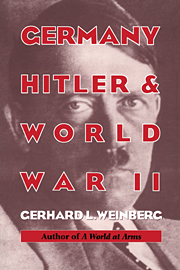Book contents
- Frontmatter
- Contents
- Preface
- Introduction
- Part I Background
- 1 The defeat of Germany in 1918 and the European balance of power
- 2 National Socialist organization and foreign policy aims in 1927
- 3 The world through Hitler's eyes
- Part II The Nazi system
- Part III Background for war
- Part IV World War II
- Appendix: the end of Ranke's history? Reflections on the fate of history in the twentieth century
- Index
3 - The world through Hitler's eyes
Published online by Cambridge University Press: 05 August 2012
- Frontmatter
- Contents
- Preface
- Introduction
- Part I Background
- 1 The defeat of Germany in 1918 and the European balance of power
- 2 National Socialist organization and foreign policy aims in 1927
- 3 The world through Hitler's eyes
- Part II The Nazi system
- Part III Background for war
- Part IV World War II
- Appendix: the end of Ranke's history? Reflections on the fate of history in the twentieth century
- Index
Summary
When Adolf Hitler became chancellor of Germany at the age of fortythree in 1933, he had held no previous position of authority in government. He had neither read intensively nor traveled extensively. He knew no foreign language. Yet he had a clearly formulated set of ideas on major issues of foreign policy, and these ideas were intimately interwoven with his concepts of domestic affairs. It is essential for an understanding of world history since 1933 that these ideas be examined in some detail, for a great part of the impact of Hitler on Germany – and of Germany on the world – lies precisely in the fact that by exertion of his will and the response it elicited inside Germany, Hitler was able to impress his ideas on events rather than allow events and realities to reshape his ideas. It is true that the effort failed. Realities that did not conform to Hitler's visions proved stronger even than his fanatic will and the mighty energies and resources the German people harnessed to it. But the great burst of activity in Germany in the 1930s, which soon spilled over Europe and affected the whole globe, was no random excitement, no accidental explosion.
There have been those who argue that Hitler was a pure opportunist, a manipulator of power, without guideposts. The shifts in the pattern of his alliances – now with the center of world communism, now with one of the sources of the so-called yellow peril – have suggested to some that plan, pattern, and ideological considerations of continuing influence must have been absent from the National Socialist scene.
- Type
- Chapter
- Information
- Germany, Hitler, and World War IIEssays in Modern German and World History, pp. 30 - 54Publisher: Cambridge University PressPrint publication year: 1995



